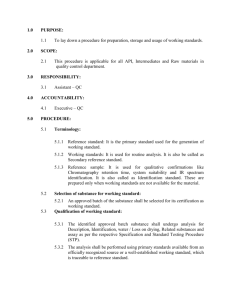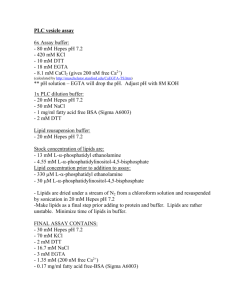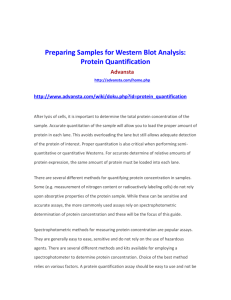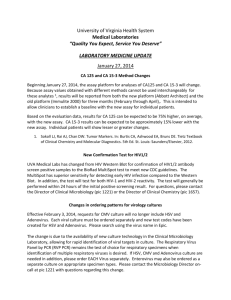Brief Scientific description of CertiChem`s in vitro assays
advertisement
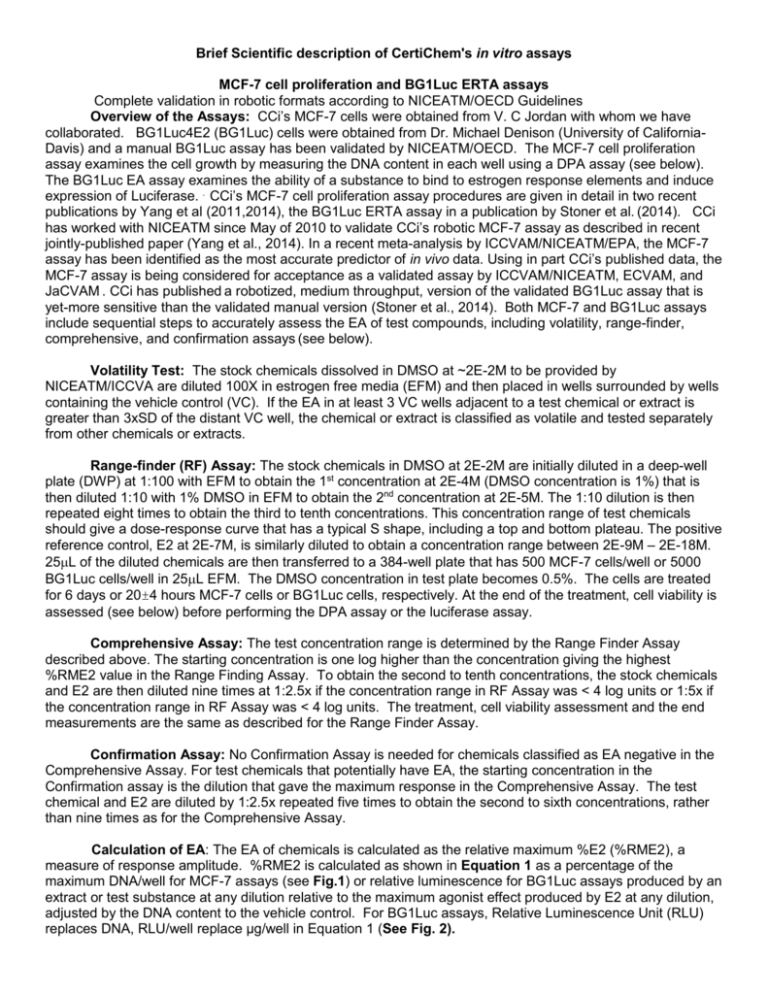
Brief Scientific description of CertiChem's in vitro assays MCF-7 cell proliferation and BG1Luc ERTA assays Complete validation in robotic formats according to NICEATM/OECD Guidelines Overview of the Assays: CCi’s MCF-7 cells were obtained from V. C Jordan with whom we have collaborated. BG1Luc4E2 (BG1Luc) cells were obtained from Dr. Michael Denison (University of CaliforniaDavis) and a manual BG1Luc assay has been validated by NICEATM/OECD. The MCF-7 cell proliferation assay examines the cell growth by measuring the DNA content in each well using a DPA assay (see below). The BG1Luc EA assay examines the ability of a substance to bind to estrogen response elements and induce expression of Luciferase. . CCi’s MCF-7 cell proliferation assay procedures are given in detail in two recent publications by Yang et al (2011,2014), the BG1Luc ERTA assay in a publication by Stoner et al. (2014). CCi has worked with NICEATM since May of 2010 to validate CCi’s robotic MCF-7 assay as described in recent jointly-published paper (Yang et al., 2014). In a recent meta-analysis by ICCVAM/NICEATM/EPA, the MCF-7 assay has been identified as the most accurate predictor of in vivo data. Using in part CCi’s published data, the MCF-7 assay is being considered for acceptance as a validated assay by ICCVAM/NICEATM, ECVAM, and JaCVAM . CCi has published a robotized, medium throughput, version of the validated BG1Luc assay that is yet-more sensitive than the validated manual version (Stoner et al., 2014). Both MCF-7 and BG1Luc assays include sequential steps to accurately assess the EA of test compounds, including volatility, range-finder, comprehensive, and confirmation assays (see below). Volatility Test: The stock chemicals dissolved in DMSO at ~2E-2M to be provided by NICEATM/ICCVA are diluted 100X in estrogen free media (EFM) and then placed in wells surrounded by wells containing the vehicle control (VC). If the EA in at least 3 VC wells adjacent to a test chemical or extract is greater than 3xSD of the distant VC well, the chemical or extract is classified as volatile and tested separately from other chemicals or extracts. Range-finder (RF) Assay: The stock chemicals in DMSO at 2E-2M are initially diluted in a deep-well plate (DWP) at 1:100 with EFM to obtain the 1st concentration at 2E-4M (DMSO concentration is 1%) that is then diluted 1:10 with 1% DMSO in EFM to obtain the 2nd concentration at 2E-5M. The 1:10 dilution is then repeated eight times to obtain the third to tenth concentrations. This concentration range of test chemicals should give a dose-response curve that has a typical S shape, including a top and bottom plateau. The positive reference control, E2 at 2E-7M, is similarly diluted to obtain a concentration range between 2E-9M – 2E-18M. 25L of the diluted chemicals are then transferred to a 384-well plate that has 500 MCF-7 cells/well or 5000 BG1Luc cells/well in 25L EFM. The DMSO concentration in test plate becomes 0.5%. The cells are treated for 6 days or 20±4 hours MCF-7 cells or BG1Luc cells, respectively. At the end of the treatment, cell viability is assessed (see below) before performing the DPA assay or the luciferase assay. Comprehensive Assay: The test concentration range is determined by the Range Finder Assay described above. The starting concentration is one log higher than the concentration giving the highest %RME2 value in the Range Finding Assay. To obtain the second to tenth concentrations, the stock chemicals and E2 are then diluted nine times at 1:2.5x if the concentration range in RF Assay was < 4 log units or 1:5x if the concentration range in RF Assay was < 4 log units. The treatment, cell viability assessment and the end measurements are the same as described for the Range Finder Assay. Confirmation Assay: No Confirmation Assay is needed for chemicals classified as EA negative in the Comprehensive Assay. For test chemicals that potentially have EA, the starting concentration in the Confirmation assay is the dilution that gave the maximum response in the Comprehensive Assay. The test chemical and E2 are diluted by 1:2.5x repeated five times to obtain the second to sixth concentrations, rather than nine times as for the Comprehensive Assay. Calculation of EA: The EA of chemicals is calculated as the relative maximum %E2 (%RME2), a measure of response amplitude. %RME2 is calculated as shown in Equation 1 as a percentage of the maximum DNA/well for MCF-7 assays (see Fig.1) or relative luminescence for BG1Luc assays produced by an extract or test substance at any dilution relative to the maximum agonist effect produced by E2 at any dilution, adjusted by the DNA content to the vehicle control. For BG1Luc assays, Relative Luminescence Unit (RLU) replaces DNA, RLU/well replace µg/well in Equation 1 (See Fig. 2). Equation 1: %RME2 =100% x MaxDNA Chem ( g/well) DNAVC ( g/well) MaxDNA E2 DNAVC ( g/well) Figure 1 Figure 1: MCF-7 agonist concentration- response curves and their suppression (Confirmation Assays) by the ER antagonist ICI for three chemicals (A,B) and four products (C-F) as stated in each Key. Note that (1) Ethyl (E.) paraben has an EA curve similar to BPA; (2) Beeswax has no detectable EA (all data points < 3SD of vehicle control (VC); (3) PCP hair and skin products have curves very similar to polycarbonate (PC) plastic extracts that release BPA, and other EDCs having EA for which hazard and risk concerns are expressed by NIH, many government and academic scientists, consumers and regulators refs. Note in Figure 1 that %RM data on individual chemicals are given in molar concentrations and extracts of mixtures in g of PCP substance/ml extraction fluid. EA Classification criteria: CCi has been working and will continue to work with NICEATM/ICCVAM scientists to define the criteria for classifying chemicals as positive, negative and equivocal. The chemical is confirmed to be EA positive if: 1) two testing concentrations produce an effect greater than 3SD of the vehicle control (VC) in the same plate and 3SD of our historical VC, a value typically about 15% RME2; 2) the %RME2 for the same testing concentrations has to be suppressed by ICI to a value smaller (less) than 3xSD of VC (dashed red lines in Figures 1& 2). A chemical is classified as negative for EA if it does not induce MCF-7 cell proliferation greater than 3SD of the assay vehicle control (VC), or if it induces proliferation that cannot be inhibited by ICI. See Figure 1 for MCF-7 and Figure 2 for BG1Luc assays, labeled as “+ ICI”. Figure 2 Figure 2: Concentration-response curves without (black solid line) and with (red solid line) 1x10-8 M ICI (+ ICI) plotted as log concentration in molarity (A-C) or in g/mL (D) versus normalized EA as %RME2 for test substances given in the key as labeled in each panel (GNT=genistein; BPA=bisphenol A; PC=polycarbonate). Dotted black line represents VC+ 3XSD. Each data point represents the normalized EA (%RME2) from three wells. Error bars = SDs for the mean of 3 replicates. Cytotoxicity Tests: CCi performs at least one of two cell viability tests for both MCF-7 and BG1Luc assays. 1: Visual Observation Assay: After cell treatment with an extract or chemical and before removing cell culture medium in the assays for EA described below, a visual inspection of cell viability is performed according to NICEATM-validated procedures, as described in previous peer-reviewed publications. 2: CellTiter-Fluor™ cell viability Assay: The CellTiter-Fluor™ cell viability assay is a nonlytic, singlereagent-addition fluorescence assay that measures the relative number of live cells in a culture population after experimental manipulation. The assay measures a conserved and constitutive protease activity within live cells and therefore serves as a marker of cell viability. Compared to most other viability assays, the same CellTiterFluor™ assay wells used for cell viability assays can also be used for the DPA assay in MCF-7 cell proliferation assays or for luminescence assays in BG1Luc assays. Briefly, one hour before removing cell culture medium in MCF-7 and BG1Luc EA assays, cell viability is assessed by adding 10µl of diluted CellTiterFluor™ reagent to all wells followed by measuring resulting fluorescence using a fluorometer (380– 400nmEx/505nm).


